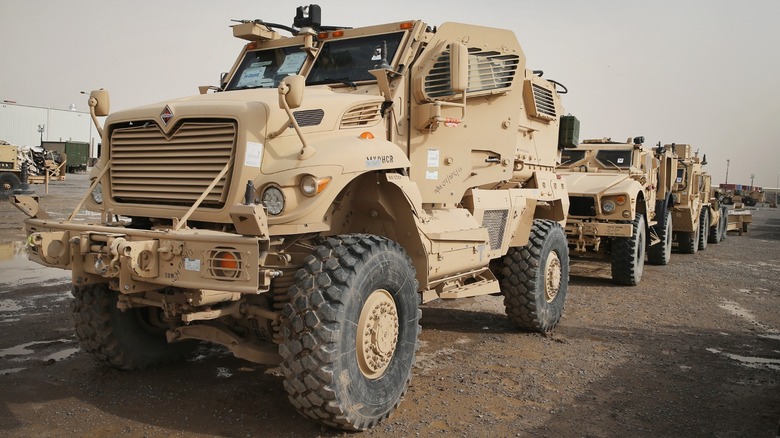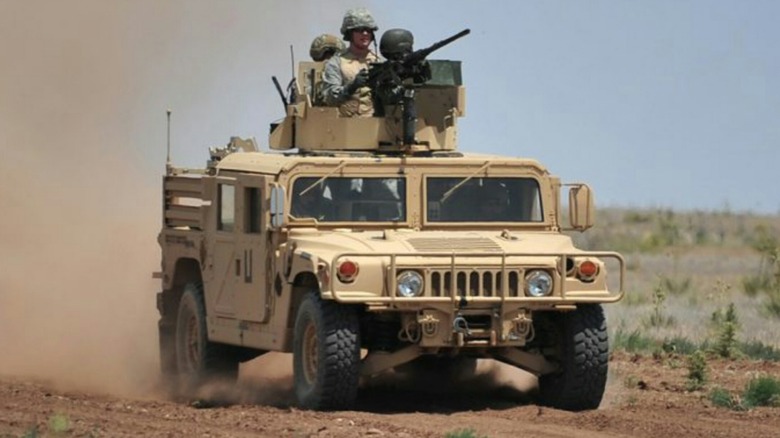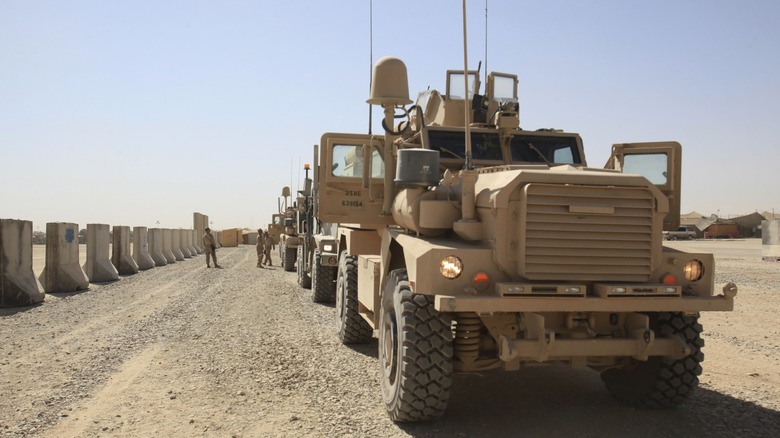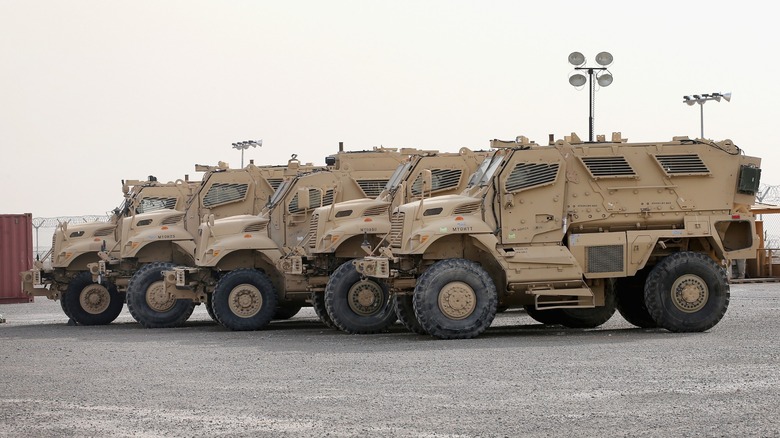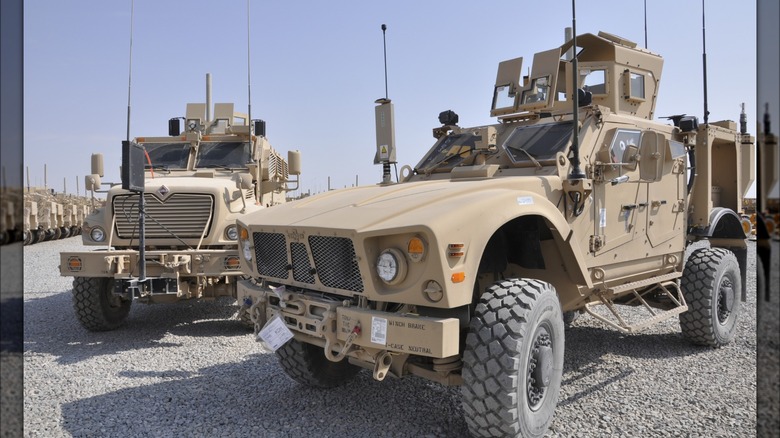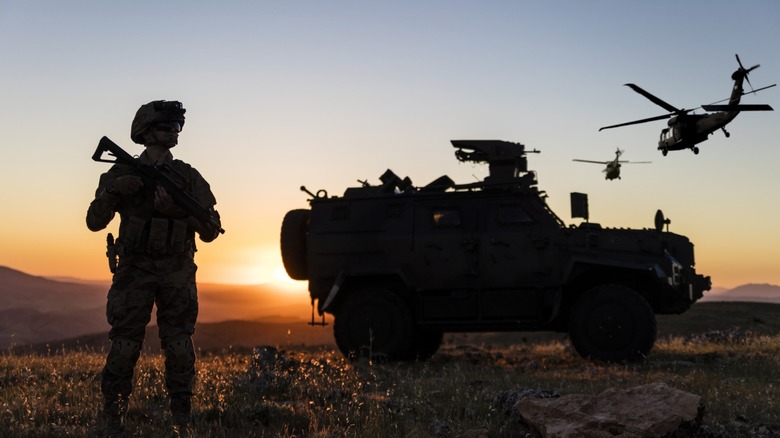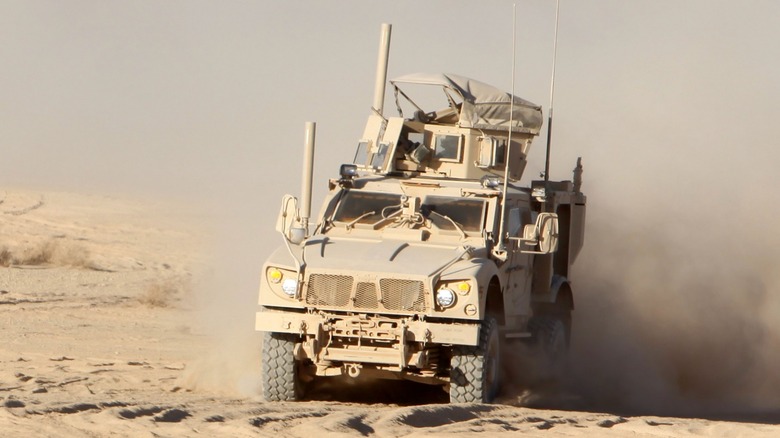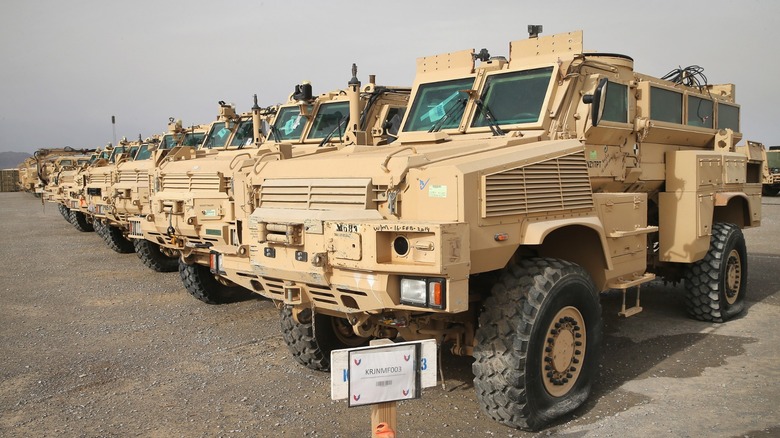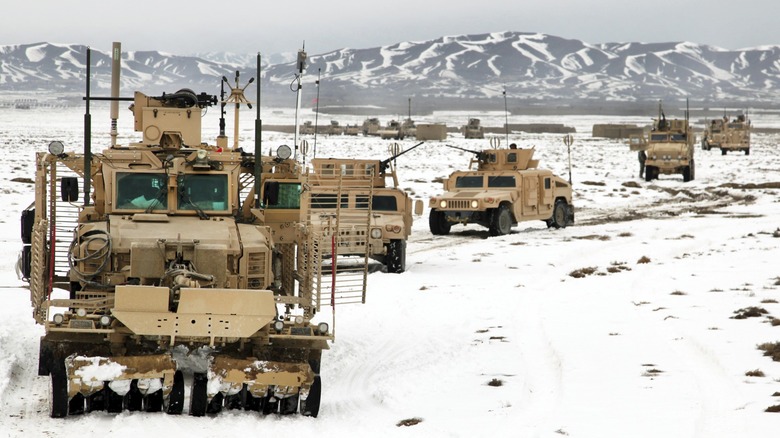MRAP Vehicles Explained: Evolution, Capabilities, And Cost
As long as there have been societies, there have been wars. They were fought on foot and horseback for most of recorded history, but the industrial revolution gave way to mechanized warfare, and battlefields were never the same. With a mechanized military comes a wide variety of machines to move soldiers across the land. In modern militaries, these vehicles generally land into one of a few classes of vehicles, differentiated for their purpose and their weight. These include vehicles such as armored personnel carriers, tanks, and amphibious vehicles for landing parties of Marines. Those are examples of heavy machinery used in combat while smaller and more nimble machines called light tactical duties fulfill different objectives entirely.
For the American military, one of its primary light tactical vehicles is called the MRAP, which stands for Mine-Resistant Ambush Protected vehicle. The MRAP is built by several manufacturers with some variation between them, but they all serve the same basic duties, protecting soldiers during operations, especially when they involve direct combat in situations very near an adversary. They are a relatively new addition to the Armed Forces, and here is an explanation of the evolution, capabilities, and cost of these rugged machines.
Genesis of the MRAP
In 1940, just before the United States entered into WWII, the War Department had sent calls for a new light tactical vehicle. The Ford GP — initials that led to it being called a Jeep – was among the first, and it, along with those made by two other companies, became the workhorses of Allied troops in WWII. It became an icon of the American military and served for decades, becoming obsolete long before being retired. The HMMWV, or High Mobility Multipurpose Wheeled Vehicle, also called the Humvee, replaced it in the '80s, itself becoming an icon thanks to a civilian version made at the urging of who would become the first buyer, Arnold Schwarzenegger, that later spawned a new GM vehicle division.
The replacement for the Humvee was the MRAP. When the U.S. entered Afghanistan and Iraq in 2001 and 2003, respectively, the Humvee was the primary light tactical vehicle for American forces. Although it had proven for years to be a rugged and capable vehicle, it was in Iraq particularly where a significant vulnerability came to light. With the dissolution of the Iraqi government and military forces, insurgency spread throughout the country. One of the primary weapons used by insurgents and militia groups was the improvised explosive device (IED), a cheap but effective homemade explosive with devastating effects on U.S. soldiers. The lack of armor plating, particularly underneath, meant these IEDs could tear through a Humvee, causing huge numbers of casualties.
Development and production
Soldiers in Iraq and Afghanistan attempted to shield themselves in the Humvee by placing sandbags on the floor but to no avail. The pressure to do something was heating up in the Department of Defense (DoD) because of the mounting casualties taking place in Humvees, with armor plating being quickly developed to strengthen the Humvee, but it was not enough. The problem with an armored Humvee is that the blasts usually came from the ground, and most of the armor was on the side, leaving soldiers unprotected from the blast.
In the late '70s Rhodesian Bush War, South African forces created a mine-resistant transport vehicle with a V-shaped hull to direct the blast from mines away from the vehicle to keep the soldiers safe. This concept had been picked up by defense industry contractors in the U.S. and crafted into a working prototype for a similar, but far more advanced type of protected vehicle. Defense Secretary Robert Gates wrangled Congress to provide funds for an armor-protected vehicle, issued a call for contracts, and received word that there was something that fulfilled requirements almost ready for production. With precious little time to work on a typical development schedule that gets a piece of equipment improved to near perfection, the MRAP was greenlit for production. By July 2007, MRAPs had been delivered to the Army, marking the program as the fastest and most important procurement by the DoD since WWII.
MRAP overview
The most important feature of an MRAP is its hull. Most vehicles, including the Humvee, have a relatively flat bottom rarely made with armor plating, except for forward attack vehicles such as tanks and armored personnel carriers. The MRAP hull is V-shaped and made of thick welded armor plating that serves as a protective barrier against a blast. The V-shape directs a blast up and away from the vehicle, with the Navistar MaxxPro engineered to survive a 172-pound land mine or IED. The vehicle is constructed of a passenger capsule mounted atop a heavy-duty truck chassis, similar to that of a school bus or heavy tow truck, but significantly more robust. They're powered by turbo diesel engines both because of the need for high torque for the weight and because of the NATO requirement of a single fuel for all ground-based vehicles.
Several companies build MRAPS, but all are built with all-wheel-drive systems that drive huge tires connected to a central pneumatic system that can deflate tires. These are also a run-flat variety for soft terrain that can inflate again on the go. Power ratings of various models average around 375 horsepower with nearly 1,000 lb-ft of torque. The armor plating, heavy-duty suspension, and specialized military equipment make these vehicles around 30,000 pounds. A wide variety of equipment can be installed on and in an MRAP. This includes electronic warfare and surveillance equipment along with various guns and cannons, and more specialized gear, such as mine clearing kit.
MRAP variants
The ifferent models of MRAPS are grouped into four categories. Category I MRAP vehicles are the lightest and are used for general purposes, including urban combat and ambulance duties. Category II is a Joint Explosive Ordnance Rapid Response Vehicle (JERRV), which serves as a convoy lead vehicle, troop transport, ambulance, and utility vehicle. These are larger and heavier, with the ability to carry more troops and equipment. They're extremely heavy, weighing up to 25 tons and often having six wheels. Category III includes only the FPI Buffalo MRV, used primarily for minefield clearing. This beast of a machine weighs 25 tons and can carry 13 personnel.
The fourth variant is simply labeled the M-ATV, or MRAP-All Terrain Vehicle. It was developed a couple of years behind the initial program as an updated model that addressed some concerns based on feedback from soldiers using the MRAPs in the field. It's lighter and faster, less prone to rollover, and more capable of maneuvering in tight quarters. It's armored the same and offers the same level of protection as the others, but handles rugged terrain much more capably. The first of these was deployed in October 2009.
MRAPs have also been made outside of the U.S., made with foreign military specifications but similar to American models. Turkey has built the Kirpi, Britain builds its Ocelot, which replaced a military Land Rover, and the German model is the Dingo, which is based on the popular Mercedes-Benz Unimog chassis, to name a few.
Effectiveness in combat
When it entered service in Iraq, the situation for soldiers in active engagement with insurgents was grim. The proliferation of IEDs put them on edge, fearing danger from a blast that could be anywhere, including hidden in a pile of rubbish on the street. The Humvee offered little protection from such explosives, leading to far too many American casualties.
The introduction of the MRAP shifted the balance of power as this new equipment was designed and constructed specifically to counter this threat. According to a 2011 report from Congress, the casualty rate for the MRAP was 6%, and compared to the 22% of the Humvee — the reduction of loss of soldiers was significant. Furthermore, Humvee occupants were killed in 80% of roadside attacks through July 2010, and the same attacks against MRAPs in the following period reduced fatalities to 15%, demonstrating their remarkable effectiveness.
Despite this, the MRAP is not without downsides. They are tall and top-heavy, making rollover a very real danger. They are also large and cannot operate in tight spaces, and the height of their antennas, reaching up to 16 feet, can accidentally contact power lines and electrocute the passengers. Furthermore, maintenance and logistics require far more resources than its predecessor, and they include more specialized and sophisticated equipment. Most importantly, they are not invincible, and, when coming into range of modern high-tech weapons, such as anti-tank missiles, they can still be destroyed, making them somewhat less effective in conventional warfare.
Capabilities in the field
The foremost mission of the MRAP is to protect personnel against attack. However, it fulfills many purposes beyond that. Aside from the mine-clearing Buffalo, MRAPs can be tooled to serve many functions. The original contracts called for the production of vehicles to be used for urban combat missions. This would provide basic logistics for troops and supplies to arrive safely to destinations within their objectives while maintaining defensive capabilities while en route. It is an offensive vehicle by nature, and, before its deployment, Army units needed infantry support dedicated to the mission and could complete the same objectives with independent operations in the MRAPs.
Some of its shortcomings discovered after soldiers had some experience with MRAPs in action were remedied once feedback from the field made its way back to Washington. The M-ATV is the response to complaints of rollovers and inability to travel in the tight urban spaces in which operations occurred. This made it especially useful in the mountainous regions of Afghanistan where roads, where they existed, would be steep, narrow, and full of jagged rock and an abundance of fine sand that troops called "space dust." These are roads that a Humvee could handle better than an MRAP, but the "space dust" also served to hide IEDs. Being slightly smaller than the MRAP and having significant wheel travel, the M-ATV proved to be a good choice for direct combat operations in the country.
Program and unit costs
The cost per unit of MRAP ranges from $300,000 to $500,000. The initial program ending in 2012 cost the federal government about $45 billion. Many have argued that the cost of losing more personnel cannot be quantified. Nonetheless, some say the program was too expensive and even unnecessary. The program was rushed and much of the usual testing was bypassed for expediency.
Recent assessments of the MRAP program take a less favorable view than some of the contemporary reports of the top brass at the Pentagon and their political allies in Washington. $40 billion was spent producing thousands of MRAPS, leading many to view the program as a boondoggle. According to a 2012 Foreign Affairs article, military assessments of the lives saved by MRAPs were likely optimistic, using assumptions that may not have been realistic, such as assuming any IED would kill all occupants of a Humvee. One argument made is that these vehicles are well-suited to some very specific situations, but that in many, if not most, they are inappropriate and ineffectively used.
With the vast surplus of MRAPs following withdrawals from Iraq and Afghanistan, the DoD devised a program to offload excess inventory to law enforcement and heavily discounted prices using its "1033" program developed originally in 1996. The ACLU argues that equipment such as the MRAP is inappropriate for police duties, yet thousands were transferred for pennies on the dollar, further militarizing our police force with little proof it improves community safety.
MRAP legacy and future
The apparent success of the MRAP cemented its place in the military, even though some arguments question its actual value relative to the cost. Even though thousands of surplus vehicles have been offloaded, the DoD maintains a massive fleet that continues to serve relatively unchanged since its introduction more than a decade ago. And still, for some missions, there is no better vehicle to complete the objective and ensure the safety of our personnel.
Development of the MRAP is ongoing. Technology under development includes electronics stability control to keep the top-heavy vehicles safer. This will also provide for future autonomous operating capabilities, units equipped with electronic warfare signal jammers, and hybrid electric drivetrains. MRAPs are part of a wide-ranging U.S. Army initiative to assess how it can reduce reliance on fossil fuels with new energy-efficient vehicle propulsion systems.
Clearly, the last chapter of the MRAP is yet to be written. However, it's highly unlikely a civilian version like the Jeep or Hummer will be coming any time soon, as these are giant heavy-duty trucks that cost half a million dollars. But if you find yourself enlisted and out on patrol in some far-flung conflict-ridden hotspot, be thankful for the safety and security provided by your unit's own MRAP, as it could very well save your life.
